Summary and Important Provisions
Updated: 05/06/2021 – Rule now in effect: AR, MD, NV, WI, TN as well
According to the USEPA, the new Hazardous Waste Generators Improvement Rule “finalizes a much-needed update to the hazardous waste generator regulations to make the rules easier to understand, facilitate better compliance, provide greater flexibility in how hazardous waste is managed and close important gaps in the regulations.” As with most new RCRA regulations/updates, adoption is done on a state by state basis. “Authorized” states that manage the RCRA program in their states will go through their authorization process to adopt the rule. As a reminder, new requirements that are more stringent than the old requirements must be adopted. Authorized states can choose to adopt the less stringent provisions and those provisions that are considered equally stringent.
The rule became effective federally on May 30, 2017 and in certain states (not authorized and early adopters by statute)- AK, IA, NJ and PA and U.S. Territories. As of this writing the rule is now in effect in 32 states.
AR, CA, CT, DE, D.C., KS, ME, MD, MA, MN, MO, MT, NE, NV, NY, OR, TE, TX, and WI are the states where the rule is not yet in effect. However, it does seem that DE, D.C., OR and TX are in the process of adopting it in late 2020 or early-to-mid 2021.
Important provisions include:
- Consolidated regulations for Hazardous Waste Generators into 40CFR262
- More clearly defined Generator status (VSQG, SQG and LQG)
- Formalized waste determination process
- Clarified Satellite Accumulation rules
- Specified additional marking requirements for wastes in Satellite Accumulation and Centralized Accumulations Areas (CAA)
- Required SQG’s to file regular updates on waste generating activities
- Allowed VSQG’s and SQG’s to exceed waste generation quantities in certain instances (Episodic Generation)
- Allowed VSQG sites to ship their hazardous wastes to LQG’s owned by the same person
- Required LQG’s to go through formal closure of CAA’s
- Required LQG’s to provide a “quick reference guide” of their contingency plan to local emergency responders.
The below chart details the impacts by generator classifications:

The dark blue/highlighted entries are the less stringent provisions of the rule.
We will provide detail on all the provisions in the next installment.

